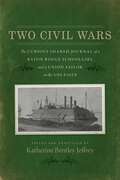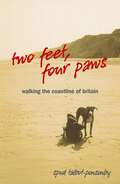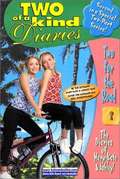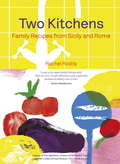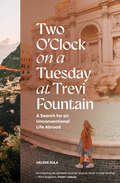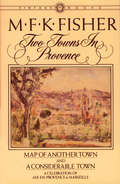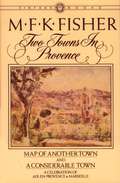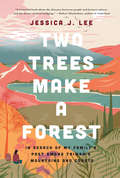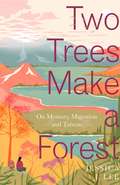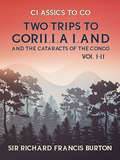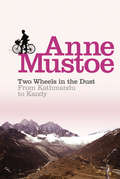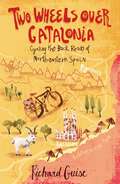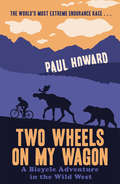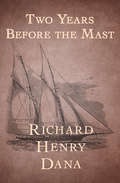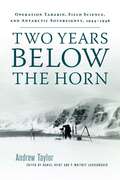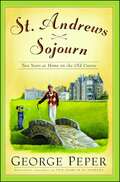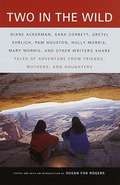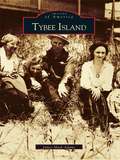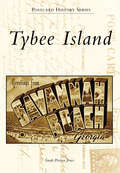- Table View
- List View
Two Civil Wars: The Curious Shared Journal of a Baton Rouge Schoolgirl and a Union Sailor on the USS Essex
by Katherine Bentley JeffreyTwo Civil Wars is both an edition of an unusual Civil War--era double journal and a narrative about the two writers who composed its contents. The initial journal entries were written by thirteen-year-old Celeste Repp while a student at St. Mary's Academy, a prominent but short-lived girls school in midcentury Baton Rouge. Celeste's French compositions, dating from 1859 to 1861, offer brief but poignant meditations, describe seasonal celebrations, and mention by name both her headmistress, Matilda Victor, and French instructor and priest, Father Darius Hubert. Immediately following Celeste's prettily decorated pages a new title page intervenes, introducing "An Abstract Journal Kept by William L. Park, of the U. S. gunboat Essex during the American Rebellion. " Park's diary is a fulsome three-year account of military engagements along the Mississippi and its tributaries, the bombardment of southern towns, the looting of plantations, skirmishes with Confederate guerillas, the uneasy experiment with "contrabands" (freed slaves) serving aboard ship, and the mundane circumstances of shipboard life. Very few diaries from the inland navy have survived, and this is the first journal from the ironclad Essex to be published. Jeffrey has read it alongside several unpublished accounts by Park's crewmates as well as a later memoir composed by Park in his declining years. It provides rare insight into the culture of the ironclad fleet and equally rare firsthand commentary by an ordinary sailor on events such as the sinking of CSS Arkansas and the prolonged siege of Port Hudson. Jeffrey provides detailed annotation and context for the Repp and Park journals, filling out the biographies of both writers before and after the Civil War. In Celeste's case, Jeffrey uncovers surprising connections to such prominent Baton Rouge residents as the diarist Sarah Morgan, and explores the complexity of wartime allegiances in the South through the experiences of Matilda Victor and Darius Hubert. She also unravels the mystery of how a southern youngster's school scribbler found its way into the hands of a Union sailor. In so doing, she provides a richly detailed picture of occupied Baton Rouge and especially of events surrounding the Battle of Baton Rouge in August 1862. These two unusual personal journals, linked by curious happenstance in a single notebook, open up intriguing, provocative, and surprisingly complementary new vistas on antebellum Baton Rouge and the Civil War on the Mississippi.
Two Feet, Four Paws: Walking the Coastline of Britain
by Spud Talbot-PonsonbyTake one headstrong dog and a feisty young woman, and send them off on a walk for the equivalent distance of London to Delhi. Two Feet, Four Paws is the heart-warming tale of one dog and her woman, who face the daily physical and mental challenges with a sense of humour and more determination with each mile.
Two Feet, Four Paws: Walking the Coastline of Britain
by Spud Talbot-PonsonbyTake one headstrong dog and a feisty young woman, and send them off on a walk for the equivalent distance of London to Delhi. Two Feet, Four Paws is the heart-warming tale of one dog and her woman, who face the daily physical and mental challenges with a sense of humour and more determination with each mile.
Two For The Road (Mary-Kate and Ashle, Two of a Kind Series)
by Nancy Butcher Mary-Kate Olsen Ashley OlsenDear Diary, So far this school trip to sunny Florida has been a blast. I've even been made captain of our triathalon sports team! But now Dana Woletsky has shown up and she wants to take the team away from me. She wants to take my boyfriend, Ross, away, too! How can I keep her from ruining my summer? I wish Mary-Kate could help, but she can't. She's spending all her time frantically looking for her lost diary. She says there's something in it no one should read, but she won't tell me what it is. I mean, what could be so bad? -- Ashley
Two Kitchens: 120 Family Recipes from Sicily and Rome
by Rachel RoddyFrom the award-winning weekly Guardian Cook columnist and winner of the André Simon and Guild of Food Writers' Awards comes an Italian food book of sumptuous recipes, flavours and stories from Sicily and Rome.For the last twelve years, food-writer, cook and photographer Rachel Roddy has immersed herself in the culture of Roman cooking, but it was the flavours of the south that she and her Sicilian partner, Vincenzo, often craved. Eventually the chance arose to spend more time at his old family house in south-east Sicily, where Rachel embraced the country's traditional recipes and the stories behind them. In Two Kitchens Rachel celebrates the food and flavours of Rome and Sicily and shares over 120 of these simple, everyday dishes from her two distant but connected kitchens. From tomato and salted ricotta salad, caponata and baked Sicilian pasta to lemon crumble, honeyed peaches and almond and chocolate cake, they are the authentic Italian recipes that you will want to cook again and again until you've made them your own.'This is a recipe book that reflects the way I cook and eat: uncomplicated, direct and adaptable Italian family food that reflects the season. The two kitchens of the title are my kitchens in Rome and Sicily. In a sense, though, we could have called the book "many kitchens" as I invite you to make these recipes your own.' Rachel RoddyTwo Kitchens chapters: Vegetables and Herbs - Tomatoes; Aubergines; Peas; Broad Beans; Cauliflower; Potatoes; Onions; HerbsFruit and Nuts - Lemons; Peaches; Oranges; Grapes and Figs; AlmondsMeat, Fish and Dairy - Beef and pork; Chicken; White fish; Fresh anchovies and sardines; Eggs; RicottaStorecupboard - Chickpeas; Lentils; Preserved anchovies; Flour; BreadRachel's first book, Five Quarters: Recipes and Notes from a Kitchen in Rome, won the André Simon Food Book Award and the Guild of Food Writers' First Book Award in 2015.
Two O'Clock on a Tuesday at Trevi Fountain: A Search for an Unconventional Life Abroad
by Helene Sula"An inspiring yet relatable read for anyone ready to stop settling." —Nina Ruggiero, Travel + Leisure In this inspiring travel memoir—the antidote to the &“just quit your job and ditch all your belongings to backpack the world&” mentality—a young woman explores how she took calculated risks to follow her dreams: traveling and living abroad without sacrificing stability and comfort.Like many young professionals, Helene settled into a steady 9-5, watching the clock tick by and dreaming of seeing the world one day. But after a climbing accident leaves her bedbound for months, she finds a new voice connecting with others online and starts a blog to write about her true passion: travel. When her blog takes off and a sponsored trip overseas opens her eyes, she wonders: could she lead a stable life while traveling the world?From skinny dipping in the icy Baltic and hiking Germany&’s storied Black Forest, to wrestling with visa applications and apartment hunting in medieval Heidelberg, Helene shares the realities—both the magical and the mundane—that come with chasing bold dreams and learning that home is where you make it. For those who fear change, the secret lies in taking calculated risks.Uplifting yet candid, this travel memoir will inspire others to take chances and transform their own lives. But you don&’t have to uproot your life to find meaning—just have the heart to take a leap.
Two Towns in Provence
by M. F. K. FisherThis memoir of the French provincial capital of Aix-en-Provence is, as the author tells us, "my picture, my map, of a place and therefore of myself...just as much of its reality is based on my own shadows, my inventions." A vibrant and perceptive profile of the kinship between a person and a place. M.F.K. Fisher scans the centuries to reveal the ancient sources that clarify the Marseille of today and the indestructible nature of its people A delightful journey filtered through the senses of a profound writer.
Two Towns in Provence: A Map of Another Town, and a Considerable Town
by M. F. K. FisherThis memoir of the French provincial capital of Aix-en-Provence is, as the author tells us, "my picture, my map, of a place and therefore of myself... just as much of its reality is based on my own shadows, my inventions." A vibrant and perceptive profile of the kinship between a person and a place. In A Considerable Town, M.F.K. Fisher scans the centuries to reveal the ancient sources that clarify the Marseille of today and the indestructible nature of its people. A delightful journey filtered through the senses of a profound writer.
Two Trees Make a Forest: In Search of My Family's Past Among Taiwan's Mountains and Coasts
by Jessica J. LeeThis "stunning journey through a country that is home to exhilarating natural wonders, and a scarring colonial past . . . makes breathtakingly clear the connection between nature and humanity, and offers a singular portrait of the complexities inherent to our ideas of identity, family, and love" (Refinery29).A chance discovery of letters written by her immigrant grandfather leads Jessica J. Lee to her ancestral homeland, Taiwan. There, she seeks his story while growing closer to the land he knew.Lee hikes mountains home to Formosan flamecrests, birds found nowhere else on earth, and swims in a lake of drowned cedars. She bikes flatlands where spoonbills alight by fish farms, and learns about a tree whose fruit can float in the ocean for years, awaiting landfall. Throughout, Lee unearths surprising parallels between the natural and human stories that have shaped her family and their beloved island. Joyously attentive to the natural world, Lee also turns a critical gaze upon colonialist explorers who mapped the land and named plants, relying on and often effacing the labor and knowledge of local communities.Two Trees Make a Forest is a genre–shattering book encompassing history, travel, nature, and memoir, an extraordinary narrative showing how geographical forces are interlaced with our family stories.
Two Trees Make a Forest: On Memory, Migration and Taiwan
by Jessica J. LeeI have learned many words for 'island': isle, atoll, eyot, islet, or skerry. They exist in archipelagos or alone, and always, by definition, I have understood them by their relation to water. But the Chinese word for island knows nothing of water. For a civilisation grown inland from the sea, the vastness of mountains was a better analogue: (dao, 'island') built from the relationship between earth and sky.Between tectonic plates and conflicting cultures, Taiwan is an island of extremes: high mountains, exposed flatlands, thick forests. After unearthing a hidden memoir of her grandfather's life, written on the cusp of his total memory loss, Jessica J Lee hunts his story, in parallel with exploring Taiwan, hoping to understand the quakes that brought her family from China, to Taiwan and Canada, and the ways in which our human stories are interlaced with geographical forces. Part-nature writing, part-biography, Two Trees Make a Forest traces the natural and human stories that shaped an island and a family.
Two Trips to Gorilla Land and the Cataracts of the Congo Vol I & Vol II (Classics To Go)
by Richard Francis Burton(Excerpt): "The notes which form the ground-work of these volumes have long been kept in the obscurity of manuscript: my studies of South America, of Syria and Palestine, of Iceland, and of Istria, left me scant time for the labour of preparation. Leisure and opportunity have now offered themselves, and I avail myself of them in the hope that the publication will be found useful to more than one class of readers. The many who take an interest in the life of barbarous peoples may not be displeased to hear more about the Fán; and the few who would try a fall with Mister Gorilla can learn from me how to equip themselves, whence to set out and whither to go for the best chance. Travelling with M. Paul B. du Chaillu's "First Expedition" in my hand, I jealously looked into every statement, and his numerous friends will be pleased to see how many of his assertions are confirmed by my experience."
Two Wheels In The Dust: From Kathmandu to Kandy
by Anne MustoeIndia is no place for the faint-hearted cyclist. The streets are jammed with cars, busses, rickshaws, animals, fortune-tellers, barbers, beggars and people sleeping or cooking. Following the success of her two previous outings, A Bike Ride and Lone Traveller, adventuresome ex-headmistress Anne Mustoe donned the cycle helmet once more and set out on an exhilarating journey round the Indian subcontinent. Beginning in Kathmandu in Nepal and ending in the tranquil hill town of Kandy in Sri Lanka, Anne's amazing journey is told with keen observation and the relish of the open road.
Two Wheels Over Catalonia: Cycling the Back Roads of North-Eastern Spain
by Richard GuiseSixteen years after moving to Catalonia, Richard finally finds time to slow down and explore the back roads by bicycle. Dipping into the unique history of this fiercely independent nation-within-a-nation, and chancing upon nudist beaches, ancient Iberian sites and revolutionary road-sweepers, this slow cyclist revels in authentic Catalonia.
Two Wheels Over Catalonia: Cycling the Back Roads of North-Eastern Spain
by Richard GuiseSixteen years after moving to Catalonia, Richard finally finds time to slow down and explore the back roads by bicycle. Dipping into the unique history of this fiercely independent nation-within-a-nation, and chancing upon nudist beaches, ancient Iberian sites and revolutionary road-sweepers, this slow cyclist revels in authentic Catalonia.
Two Wheels on my Wagon: A Bicycle Adventure in the Wild West
by Paul HowardAs bicycle races go, the attractions of the Tour Divide are not immediately apparent. For a start, it is the longest mountain-bike race in the world, running nearly 3,000 miles down the Rockies from Canada to Mexico. But the distance is not the only challenge - the total ascent of 200,000 ft is the equivalent of scaling Mount Everest nearly seven times.Then there are the dangerous animals likely to be encountered on the route: grizzly bears, mountain lions and wolves, not to mention rattlesnakes and tarantulas. Worse, the rewards for all this effort are strictly limited. Unlike in the Tour de France, there is no fabled yellow jersey and no prize money.Yet, undaunted, and in spite of never having owned a mountain bike, Paul Howard signed up. Battling the worst weather for generations, drinking whiskey with a cowboy and singing karaoke with the locals, Howard's journey turned into more than just a race - it became the adventure of a lifetime.
Two Years Before the Mast: A Personal Narrative Of Life At Sea
by Richard DanaThis legendary account of a voyage around Cape Horn captures the majesty and misadventure of life at sea in the early nineteenth century In 1834, nineteen-year-old Richard Henry Dana left Harvard University to enlist as a deckhand on a brig sailing from Boston to the California coast. For the next two years, he recorded the terrifying storms, awe-inspiring beauty, and dreadful hardships of the journey in a diary he would later expand into this riveting memoir of "the life of a common sailor at sea as it really is." Dana spares no detail in portraying the wretched conditions he endured and the cruelty of the ship's captain, but he also paints vivid, unforgettable pictures of natural wonders such as icebergs and schools of migrating whales. His descriptions of the missions and presidios of pre-Gold Rush California captured the imagination of the country when the book was first published in 1840, and they serve as valuable historical documentation to this day. An instant classic and inspiration for contemporaries such as Herman Melville, Two Years Before the Mast is one of the most remarkable and influential adventure stories in American literature. This ebook has been professionally proofread to ensure accuracy and readability on all devices.
Two Years Below the Horn: Operation Tabarin, Field Science, and Antarctic Sovereignty, 1944-1946
by Andrew Taylor Daniel Heidt Whitney LackenbauerIn "Two Years Below the Horn," engineer Andrew Taylor vividly recounts his experiences and accomplishments during Operation Tabarin, a landmark British expedition to Antarctica to establish sovereignty and conduct science during the Second World War. When mental strain led the operation’s first commander to resign, Taylor—a military engineer with extensive prewar surveying experience—became the first and only Canadian to lead an Antarctic expedition. As commander of the operation, Taylor oversaw construction of the first permanent base on the Antarctic continent at Hope Bay. From there, he led four-man teams on two epic sledging journeys around James Ross Island,overcoming arduous conditions and correcting cartographic mistakes made by previous explorers. The editors’ detailed afterword draws on Taylor’s extensive personal papers to highlight Taylor’s achievements and document his significant contributions to polar science. This book will appeal to readers interested in the history of polar exploration, science, and sovereignty. It also sheds light on the little known contribution of a Canadian to a distant theatre of the Second World War. The wartime service of Major Taylor reveals important new details about a groundbreaking operation that laid the foundation for the British Antarctic Survey and marked a critical moment in the transition from the heroic to the modern scientific era in polar exploration.
Two Years in St. Andrews: At Home on the 18th Hole
by George PeperThe Old Course at St. Andrews is to golfers what St. Peter's is to Catholics or the Western Wall is to Jews: hallowed ground, the course every golfer longs to play -- and master. In 1983 George Peper was playing the Old Course when he hit a slice so hideous that he never found the ball. But in looking for it, he came across a For Sale sign on a stone town house alongside the famed eighteenth hole. Two months later he and his wife, Libby, became the proud owners of 9A Gibson Place. In 2003 Peper retired after twenty-five years as the editor in chief of Golf magazine. With the younger of their two sons off to college, the Pepers decided to sell their house in the United States and relocate temporarily to the town house in St. Andrews. And so they left for the land of golf -- and single malt scotch, haggis, bagpipes, television licenses, and accents thicker than a North Sea fog. While Libby struggled with renovating an apartment that for years had been rented to students at the local university, George began his quest to break par on the Old Course. Their new neighbors were friendly, helpful, charmingly eccentric, and always serious about golf. In no time George was welcomed into the local golf crowd, joining the likes of Gordon Murray, the man who knows everyone; Sir Michael Bonallack, Britain's premier amateur golfer of the last century; and Wee Raymond Gatherum, a magnificent shotmaker whose diminutive stature belies his skills. For anyone who has ever dreamed of playing the Old Course -- and what golfer hasn't? -- this book is the next best thing. And for those who have had that privilege, Two Years in St. Andrews will revive old memories and confirm Bobby Jones's tribute, "If I were to set down to play on one golf course for the remainder of my life, I should choose the Old Course at St. Andrews."
Two in the Bush
by Gerald DurrellWhat Durrell sees down under are some species that have chalked their own path of evolution and are much different from wildlife in the bigger continents.
Two in the Wild
by Susan Fox RogersThelma and Louise get sporty (and survive) in this anthology of true stories about women whose idea of fun involves sharing adventures--big and small--in the great outdoors. In essays that not only take you to mountains, forests, lakes, and rivers but also explore the powerful and intimate bond of female companionship, the editor of Solo: On Her Own Adventure introduces sixteen daring women and their travel mates as they ski, climb, hike, bike, and drive all over the world.Trudge through the muddied roads of Australia's outback with thirty-something Sara Corbett and her childhood chum to find the legendary 80-year-old woman rumored to split wood faster than any man who challenges her. Go fishing with Holly Morris, kick back with Pam Houston and a good friend at a Denver ranch, or bike with Diane Ackerman and her friend through the "aubergine drapery of the forest" as they circumnavigate Otsego Lake. Hop in the car with Mary Morris and her baby daughter to meet the eccentrics living in the California desert, and climb the Himalayas with 54-year-old Jean Gould and her 70-year-old travel partner.Whether you are an armchair adventurer or a thrill seeker in your own right, these exhilarating essays will inspire you to dust off your bicycle, lace up your hiking boots, fill your gas tank, and take your dearest friend along for the time of your lives.From the Trade Paperback edition.
Tybee Island (Images of America)
by James Mack AdamsTybee Island is a tiny piece of land, only-two-and-a-half miles long and two-thirds of a mile wide; however, its strategic location near the mouth of the Savannah River assigned to it an important role in the birth and history of the state of Georgia. Over this coastal community five flags have flown, representing Spain, France, England, the ConfederateStates of America, and the United States of America.Using numerous vintage photographs from the archives of the Tybee Island Historical Society, Tybee Island guides the reader through over two hundred years of history. Although much of its history is linked to nearby Savannah, Tybee is singular among Georgia's coastal islands, and has a history and lore that is uniquely its own. This visual journey begins with the building of Georgia's oldest and tallest lighthouse, and continues through Tybee's involvement in the Civil War. Also covered are the island's later roles as a military installation, apopular coastal resort, and a residential community. Vintage photographs recall earlier days on Tybee, when the island was known as "Ocean City," "Savannah Beach," and, to some, "the best kept secret on the East Coast."
Tybee Island (Postcard History Series)
by Sarah Pierson JonesTybee Island has fought hard to survive wars, earthquakes, hurricanes, the Great Depression, and even Prohibition, and while Tybee fights hard, Tybee plays hard. Tybee has a unique story as one of the top tourist destinations of the early 20th century. From the early days, when people could only reach Tybee by train, to the upheavals of the 1960s and 1970s, souvenir postcards tell the story of Tybee's unique and diverse history.
Tybee Island (Postcard History Series)
by Sarah Pierson JonesTybee Island has fought hard to survive wars, earthquakes, hurricanes, the Great Depression, and even Prohibition, and while Tybee fights hard, Tybee plays hard. Tybee has a unique story as one of the top tourist destinations of the early 20th century. From the early days, when people could only reach Tybee by train, to the upheavals of the 1960s and 1970s, souvenir postcards tell the story of Tybee's unique and diverse history.
